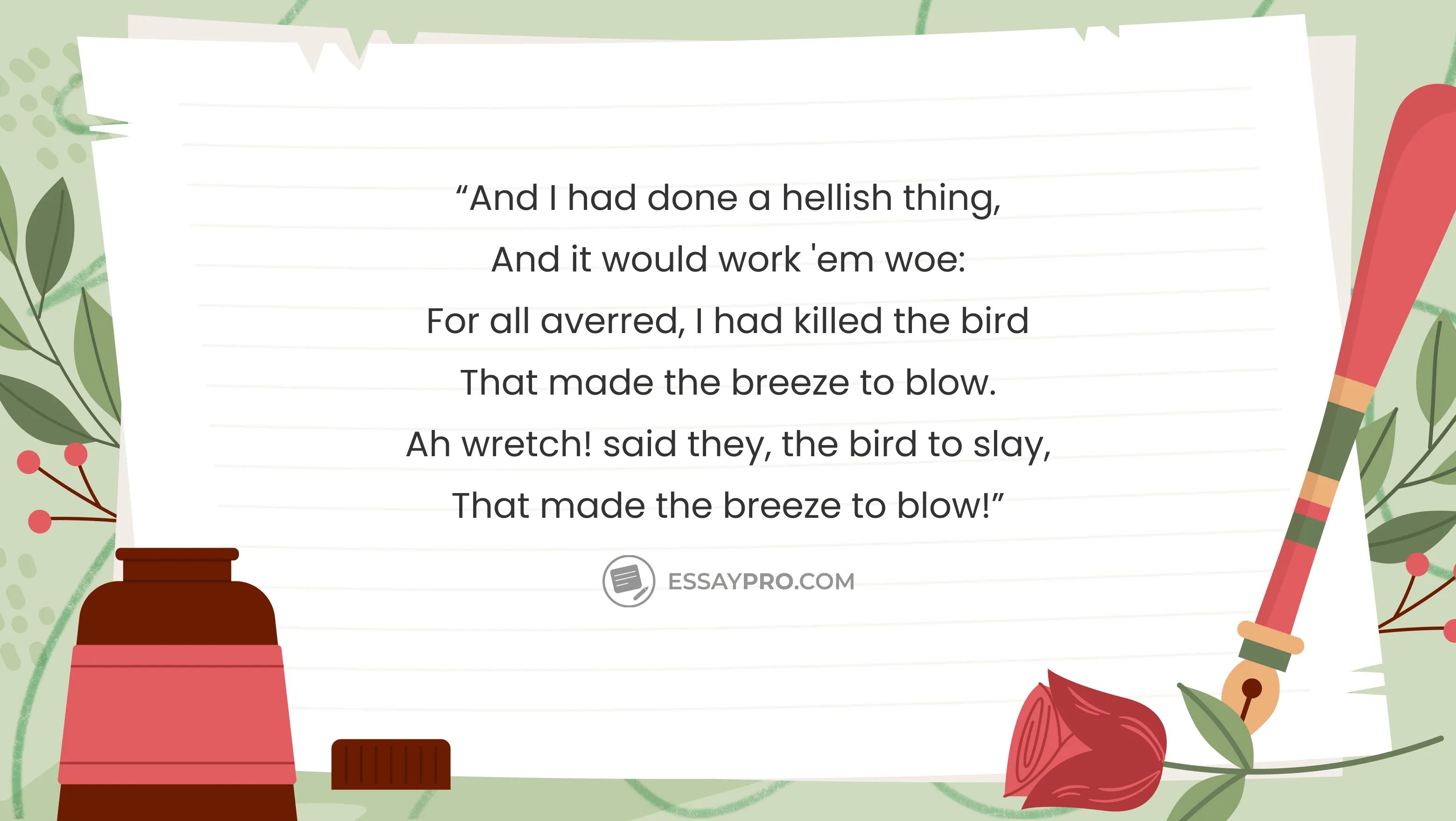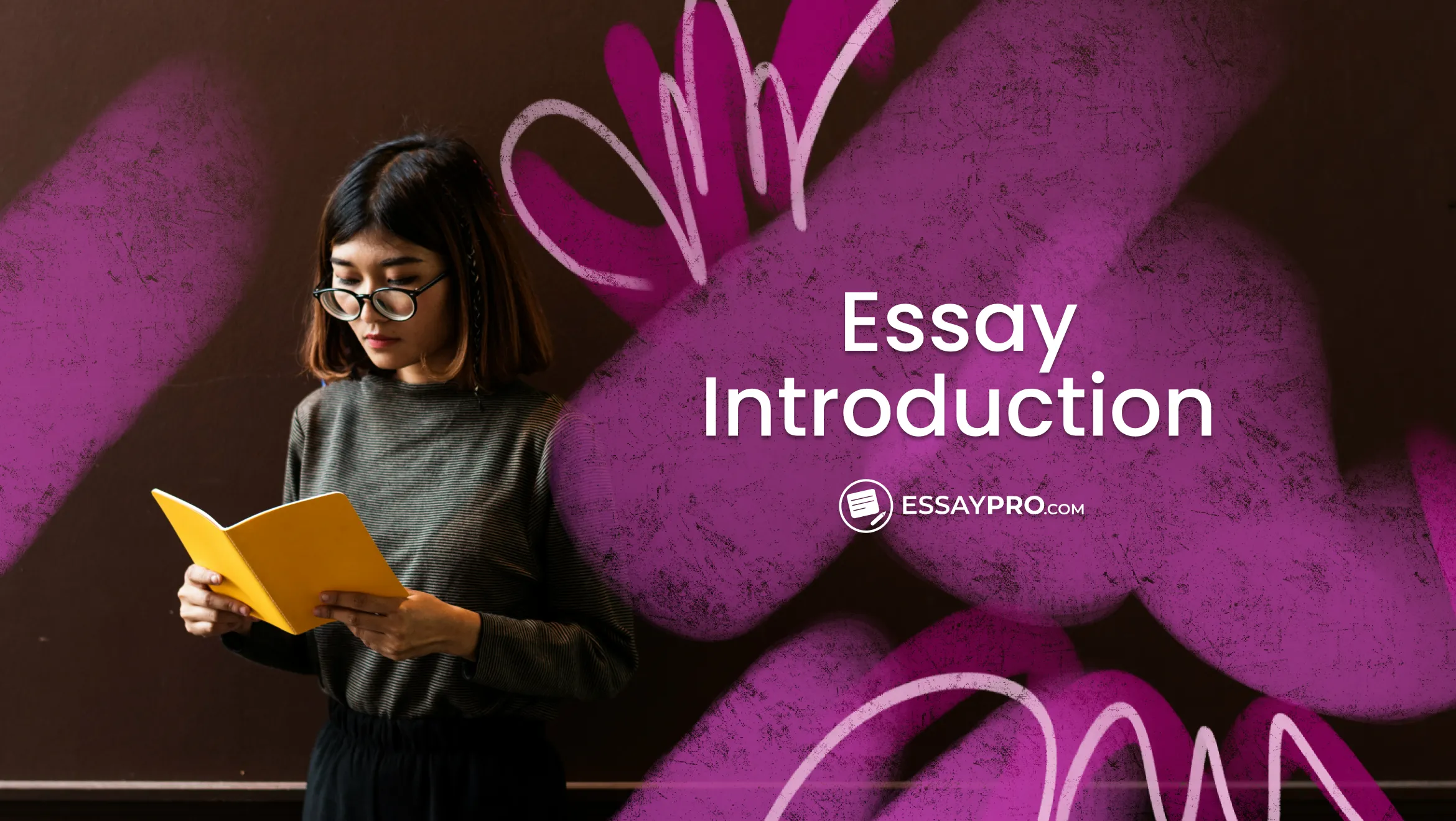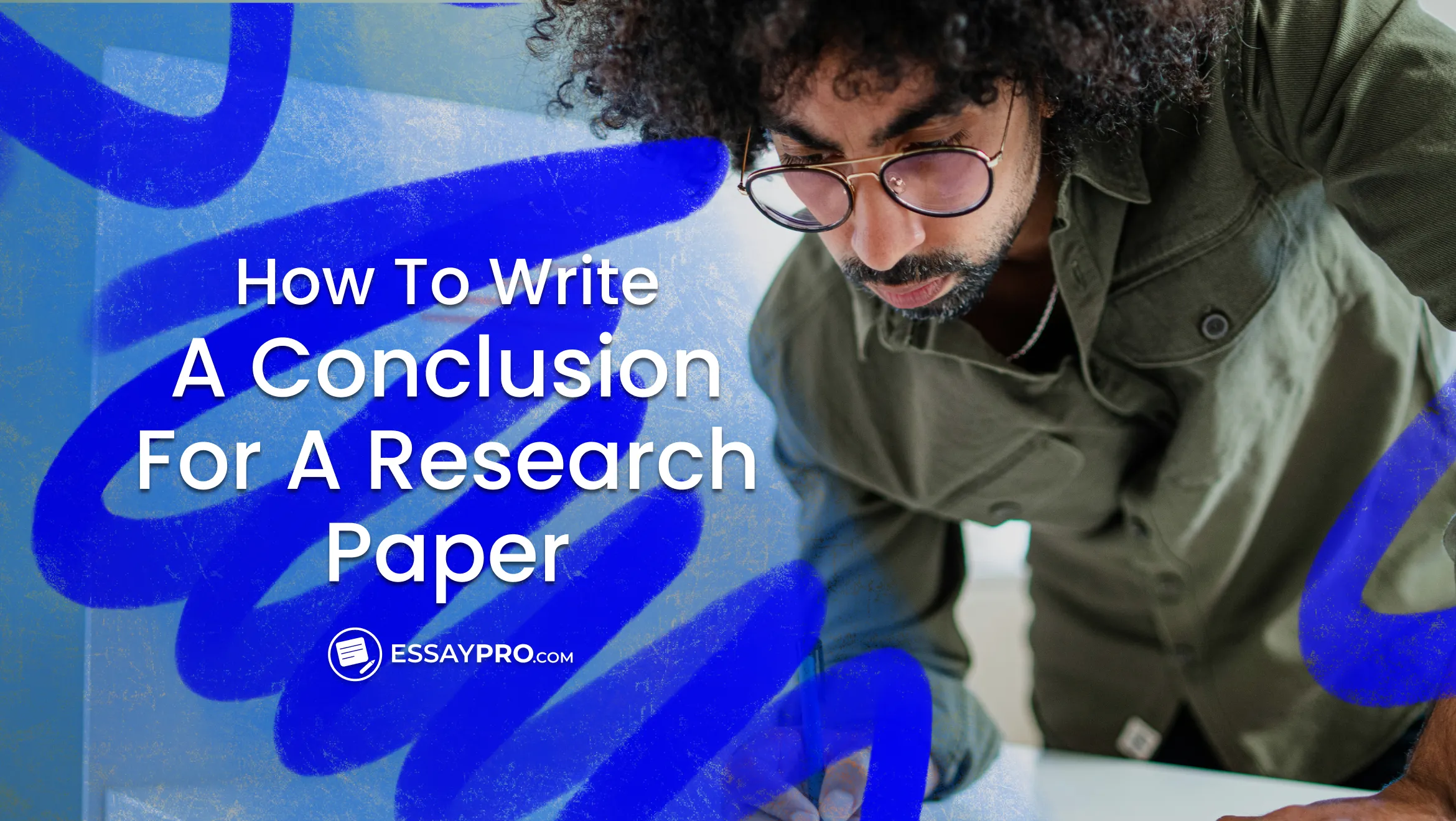Some poems hit you with emotion. Others tell a story you can’t stop reading. Narrative poetry does the latter, and does it well. You're not just following lines when you're reading a narrative poem; you're following a journey with a clear plot, characters, and even conflict. This kind of storytelling through verse isn't new. In fact, some of the most famous poems in history fall into this genre. Here are a few narrative poems that still show up in classrooms and lit circles:
- The Raven by Edgar Allan Poe
- The Rime of the Ancient Mariner by Samuel Taylor Coleridge
- The Iliad by Homer
- The Highwayman by Alfred Noyes
- The Canterbury Tales by Geoffrey Chaucer
- Beowulf (author unknown)
This guide will explain the structure of narrative poems and their differences from other forms of poetry. You'll also find characteristics of narrative poetry and narrative poem examples for students. If you need some extra help with poetry analysis or simply to buy a narrative essay online, EssayPro has your back with professional writing support for all your academic tasks.
What is a Narrative Poem?
A narrative poem tells a complete story from beginning to end. It includes a plot, characters, and a clear sequence of events, but all written in verse form. That's the core of the narrative poem definition.
Narrative poetry can be written in a specific meter, or it might even be free verse. The format matters much less than the actual story telling. Any subject with a clear storyline can work, but the most popular narrative topics include love, heroism, and personal journeys.


Difference Between Narrative Poems and Other Poetic Forms
What makes narrative poetry stand out is pretty simple: it tells a story. Other poems might drift through emotions or linger on a single image, but narrative poems move and move. They're less about atmosphere and more about action. That focus on storytelling is the defining feature that separates narrative poetry from lyric and prose poems. Let's break down what each one brings to the table and what makes them unique.
Narrative Poetry vs. Lyric Poetry
If you're reading a poem that feels like someone's private journal, that's probably lyric poetry. It's all about expressing deep emotion: one moment, one voice, one feeling. Now think about how that compares to narrative poetry that gives you a full arc with conflicts and twists. That's the most important point about the difference between narrative poetry vs. lyric poetry. Shortly put:
- Narrative poetry tells a story with a beginning, middle, and end
- Lyric poetry zooms in on a personal emotion or reflection
- Narrative poems might include dialogue, characters, and a plot
- Lyric poems focus more on rhythm, tone, and mood than action
Narrative Poetry vs. Prose Poetry
Prose poetry looks like a paragraph you'd find in a novel, but its language feels poetic. That's why prose poems are kind of shapeshifters. Even if they skip the line breaks and structure we typically expect from poems, it still leans into imagery and sound. Narrative poetry stays in verse, though. It gives you a structured plot and a full story to follow. Here’s how they compare:
- Narrative poems follow a line-and-stanza structure, often with rhyme or meter
- Prose poems use block paragraphs but still sound poetic
- Narrative poetry includes a clear story arc, with characters and events
- Prose poetry focuses more on sensations, abstract ideas, or images than on story
Narrative Poem Examples
Narrative poetry examples are everywhere in classic and modern literature. Some of them have stood the test of time, and it's definitely for a good reason. These poems tell detailed stories that are full of both action and emotion. In this section, we'll take a look at some of the most famous narrative poem examples ever written that show exactly how powerful storytelling in verse can be.
The Iliad by Homer
The Iliad is a war story, but it’s not just about battle strategies. Homer tells us about pride, rage, grief, and what it means to be remembered. The poem drops you right into the middle of the Trojan War, where the Greek warrior Achilles is furious at his own army for disrespecting him. He refuses to fight, and that choice has massive consequences. While armies clash outside the walls of Troy, gods argue in the skies and heroes face off in brutal duels. The Iliad is about the cost of anger and the fragile line between glory and destruction.

The Canterbury Tales by Geoffrey Chaucer
The Canterbury Tales follows a group of pilgrims on their way to Canterbury, each taking turns telling a story along the journey. Some are funny, some are serious, and a few are surprisingly dark. Through these tales, Chaucer tells us about the beliefs and flaws of the middle ages. Stories by each character reveal just as much about them as the world they live in. It’s one poem, but it feels like a whole collection of voices and viewpoints packed into one trip.

The Rime of the Ancient Mariner by Samuel Taylor Coleridge
This haunting narrative poem begins with an old sailor stopping a wedding guest to tell a strange story. The mariner recalls a doomed sea voyage where he made a terrible mistake: shooting an albatross, a bird that was bringing good luck to the ship. It's followed by a surreal and eerie tale filled with curses and ghosts, isolation and guilt. As the mariner suffers through supernatural punishment, the poem digs deep into the weight of one’s choices. It’s mysterious and hard to shake off once you’ve read it.

Annabel Lee by Edgar Allan Poe
This haunting narrative poem tells the story of a love that continues beyond the grave. It tells the story of a man whose young love, Annabel Lee, dies, but their love is so strong that not even death can really part them. Poe's use of repetitive phrases and a melancholic rhythm emphasizes his eternal love for Annabel Lee and gives the poem a song-like quality.

The Highwayman by Alfred Noyes
Set during the 18th century in Britain, this poem tells the tragic love story of a highwayman and an innkeeper's daughter, Bess. The story takes a dark turn when soldiers use Bess as bait to catch him. Noyes captures the tension and the doomed romance with vivid imagery and a steady rhythm that builds up the suspense.

The Lady of Shalott by Alfred, Lord Tennyson
Tennyson tells the story of the Lady of Shalott, who is cursed to only look at the outside world through a mirror. Spellbound by the sight of Sir Lancelot, she looks out the window, triggering her tragic fate. The poem has a mystical, dreamy feel, and Tennyson’s use of rich descriptions brings her isolated world to life.

Casey at the Bat by Ernest Lawrence Thayer
This one is lighter but no less dramatic. It’s about a baseball star, Casey, who has the chance to be the hero but strikes out instead when his team needs him most. Thayer really captures the highs and lows of sports in a way that’s both fun and a little bit heartbreaking, using playful language and a clear, catchy rhythm.

The Ballad of Charlotte Dymond by Charles Causley
Based on a true story, this ballad tells the mystery surrounding the murder of Charlotte Dymond on Bodmin Moor in 1844. Told from the perspective of her boyfriend who was accused and hanged for the crime, it’s a tale of love and betrayal, set against the bleak, windswept moors of Cornwall.

The Hound of Heaven by Francis Thompson
The Hound of Heaven is a deeply personal and spiritual poem about running from something that never stops chasing you: God’s love. The speaker tries to escape through pleasure, fear, and distraction, but no matter where he turns, the “hound” is always there, patient and persistent. It’s not a poem about punishment, it’s about mercy that refuses to give up. Thompson’s language is rich and emotional, and the imagery paints a powerful picture of a soul slowly realizing it’s been loved all along.

The Cremation of Sam McGee by Robert W. Service
The Cremation of Sam McGee is a darkly funny and strangely heartwarming poem set in the icy Yukon. It follows a man named Cap who promises to cremate his friend Sam after he dies, because Sam just couldn’t stand the cold. What unfolds is a bizarre and unforgettable journey through snow and fire. With its steady rhythm and vivid storytelling, the poem tells about the harshness of frontier life while still managing to keep a playful tone.

And if you’re quoting from your favorite poets, make sure you do it right. Here’s a guide on how to cite poems to help you out.
Types of Narrative Poems
Narrative poems come in all shapes and tastes, each with its own way of telling a story. Let’s look at the different types of narrative poems, starting with the epic poem:
Epic Poems
Epic poems are the big, adventurous stories of the poetry world, focusing on heroes, their journeys, and their battles. These long poems often explore themes like bravery, duty, and the fight between good and evil.
While many people know classics like Homer’s Iliad and Odyssey, there are other examples of epic poems that have made a huge impact:
- Virgil’s The Aeneid: This is the story of Aeneas, a Trojan hero who travels to Italy and becomes the ancestor of the Romans. It’s a tale of destiny and the founding of Rome.
- Ferdowsi’s Shahnameh ("The Book of Kings"): This epic tells the history of Persia, from its mythical origins to the Islamic conquest, with stories of kings, heroes, and epic battles.
- The Epic of Sundiata (Mali): This West African epic tells the story of Sundiata Keita, the founder of the Mali Empire. It’s a tale of resilience, leadership, and the rise of one of Africa’s greatest empires.
Ballads
Ballads are short, narrative poems that pack a punch with their simplicity and rhythm. These poems often tell dramatic and emotional stories, making them memorable and engaging.
Unlike epics, ballads are typically concise, usually just a few stanzas long. They’re characterized by their rhythmic, repetitive structure, which makes them easy to remember and recite. Traditional ballads often explore themes of love, tragedy, or historical events, and they frequently feature dialogue and a clear, linear plot.
Here are a few classic ballad poem examples:
- Samuel Taylor Coleridge’s The Rime of the Ancient Mariner: A tale of a sailor’s cursed voyage and his quest for redemption.
- Barbara Allen: A traditional English ballad about unrequited love and its tragic consequences.
- The Ballad of John Henry: An American folk ballad about the legendary steel driver who battled against a steam drill.
Arthurian Romance
Arthurian romances transport us to the legendary world of King Arthur and his knights. These poems aren’t as lengthy as epics but are richer than ballads, mixing adventure, chivalry, and romance into their storytelling.
They often follow a formal structure and are set in a legendary version of medieval Europe, full of quests, magical beings, and courtly love. Here are a few standout Arthurian romances:
- Sir Gawain and the Green Knight: This story features Sir Gawain accepting a mysterious challenge from the Green Knight, testing his bravery and honor.
- The Lancelot-Grail Cycle: This series focuses on Sir Lancelot, his forbidden love for Queen Guinevere, and the search for the legendary Holy Grail.
- T.H. White’s The Once and Future King: This modern twist on the Arthurian legends follows King Arthur’s journey from his youth to his destiny.
Idyll
Idylls are poems that paint a picture of peaceful, often idealized scenes from the countryside or nature. They're like short, vivid snapshots of calm and beauty, showing us moments of tranquility. The word "idyll" actually comes from a Greek term that means "little picture," which fits perfectly since these poems focus on serene and picturesque settings.
In essence, idyll meaning is about celebrating those perfect, peaceful moments in nature or simple rural life. They give us a refreshing break from the busy pace of everyday life, highlighting the beauty and calm around us.
Here are a few examples of what idylls can look like:
- Christopher Marlowe’s The Passionate Shepherd to His Love: This poem invites the reader into a rural paradise where spring lasts forever and life is simple but rich.
- Alfred, Lord Tennyson’s Idylls of the King: While it’s based on Arthurian legends, this collection also presents idealized scenes of nature and pastoral life.
- Virgil’s Eclogues: These ancient pastoral poems depict the peaceful lives of shepherds, offering a timeless glimpse into an idealized rural existence.
Сharacteristics of Narrative Poetry
Here are some features that set narrative poems apart from other types of poetry:
- Storytelling at Heart: The biggest draw of narrative poetry is its focus on telling a story. These poems lay out characters, settings, conflicts, and resolutions just like a short story might. They pull you into their world and keep you there until the very end.
- Playing with Words: Narrative poets love to get creative with their language. They’ll pick words that might surprise you or phrases that make you pause and think. The goal here is to present it in a way that sticks with you, whether it moves, shocks, or delights.
- Mixing Up the Timeline: These poems aren’t afraid to shake things up. Some might jump around in time, start in the middle of the action, or piece together different parts of the story before tying them all up.
- Variety in Form: There’s no standard template for a narrative poem. They can change shape based on the tale they’re telling, the era they’re from, or the culture they represent. Today, many narrative poets opt for free verse, which lets them bend the poem to fit the story perfectly.
- A Touch of Myth: Many narrative poems use mythology to enrich their stories. This use of myth can connect a story to larger, universal themes, making it resonate more deeply.
How To Write A Narrative Poem In Six Steps
You’ll need more than just a clever rhyme or a few pretty lines if you want to create a narrative poem. You're telling a story, so the structure must be on point so the reader can follow it. The pacing and the voice need to work together with the structure so everything is neatly organized. Just like a short story, narrative poems follow a plot, but they still play with language the way only poetry can.
You need to follow a few simple steps to write a narrative poem:
- Get inspired
- Build your storyline
- Pick your narrator
- Paint with your senses
- Add poetic layers
- Play with structure
1. Get Inspired
Every narrative poem begins with a spark. That inspiration can come from something you lived through or something you wish you had. Think about old myths you can't shake, characters with secrets, even dreams you half-remember; they can all be seeds of something powerful. The best poems often begin with a simple “what if?” and grow into a world worth stepping into.
2. Build Your Storyline
A strong plot matters in poetry as much as it does in prose. Once your idea takes shape, start mapping out the essentials: who’s at the center of the story, what’s happening around them, and why it matters. A strong narrative poem moves with purpose. It has a clear beginning, a turning point, and a resolution that lands. Keep the storyline focused, but give it room to breathe. Even a small moment or quiet conflict can hit hard when it’s told with care.
3. Pick Your Narrator
The voice you choose sets the tone for everything. Writing in first person pulls the reader in close: it feels immediate, like we’re inside the moment. The third person gives you more room to zoom out and guide the story with a wider lens. Some poems even shift between voices to create contrast or tension. Think about who’s telling the story, and how close you want the reader to stand. A strong narrative voice doesn’t need a lot of words to leave a lasting impression.
4. Paint With Your Senses
Great narrative poetry drops you right inside the story. The wind bites, the floorboards creak, the air smells like smoke and something unsaid. That’s the power of strong imagery and sensory detail. When you let readers see what your character sees and feel what they feel, the poem starts to live and breathe. Those small moments change everything: they draw people in and hold them there.
5. Add Poetic Layers
Poetry hands you a toolkit that prose doesn’t always reach for. Metaphors, similes, personification, and symbolism all add layers beneath the surface of your story. With just a few carefully chosen lines, you can say something bigger without spelling it out. Figurative language gives your narrative poem texture. It makes the meaning linger, even after the story’s done.
6. Play With Structure
Narrative poems don’t all follow the same form. Some rhyme, some don’t. Some stick to a meter, others flow freely. Try out different line lengths, stanza breaks, or rhythm patterns. See what matches the mood and movement of your story. The structure should feel natural, like it fits the story you’re telling, not just the rules of poetry.
Your Story, Your Lines
Narrative poetry gives you space to tell an entire story that moves and leaves something behind. Before you start writing, here's a quick recap of what we've covered in our guide:
- Narrative poems follow a story structure with characters, conflict, and resolution
- Unlike other forms, they focus on action and movement rather than emotion alone
- Classic examples like The Iliad, The Raven, and The Canterbury Tales show how much story a poem can hold
- Writing narrative poetry takes more than just inspiration. You’ll need to find a clear voice, vivid language, and a plot that carries meaning
- There’s no single formula to follow, but structure and language should serve the story you want to tell
A little guidance goes a long way, regardless of whether breaking down a poem for class or writing your own. Whenever you feel stuck, you can rely on EssayPro's online essay services that can give you a hand with creative writing or routine academic assignments.
Can't Find Inspiration?
The right words don't always come easily. Let the professionals help make your writing unforgettable.
FAQ
What Is an Example of a Narrative Poem For Students?
A great narrative poem example for students is Robert Frost’s "The Road Not Taken." This poem tells a story about making choices and their consequences, all through a simple and relatable narrative. It’s a good pick for students because it’s straightforward yet thought-provoking, making it easier to understand how a narrative poem works while exploring its themes.
What Is the Meaning Of Narrative Poetry?
Narrative poetry is basically a type of poem that tells a story. When we talk about narrative poem meaning, we’re referring to poems with characters, a plot, and a setting, much like a short story or novel. Instead of focusing just on feelings or moments, these poems unfold a complete story in verse, engaging readers with a plot and events.
What Is a Good Sentence Starter For Narrative Poetry?
A good way to start a narrative poetry piece might be to set the scene or introduce a situation. For example, you could start with something like, "On a chilly autumn evening, as the leaves rustled underfoot, a stranger appeared at the edge of town." This kind of opening draws readers into the story and sets up the action that will follow.

Adam Jason
is an expert in nursing and healthcare, with a strong background in history, law, and literature. Holding advanced degrees in nursing and public health, his analytical approach and comprehensive knowledge help students navigate complex topics. On EssayPro blog, Adam provides insightful articles on everything from historical analysis to the intricacies of healthcare policies. In his downtime, he enjoys historical documentaries and volunteering at local clinics.
What are narrative poems? (n.d.). BBC Bitesize. https://www.bbc.co.uk/bitesize/articles/z3btrwx






